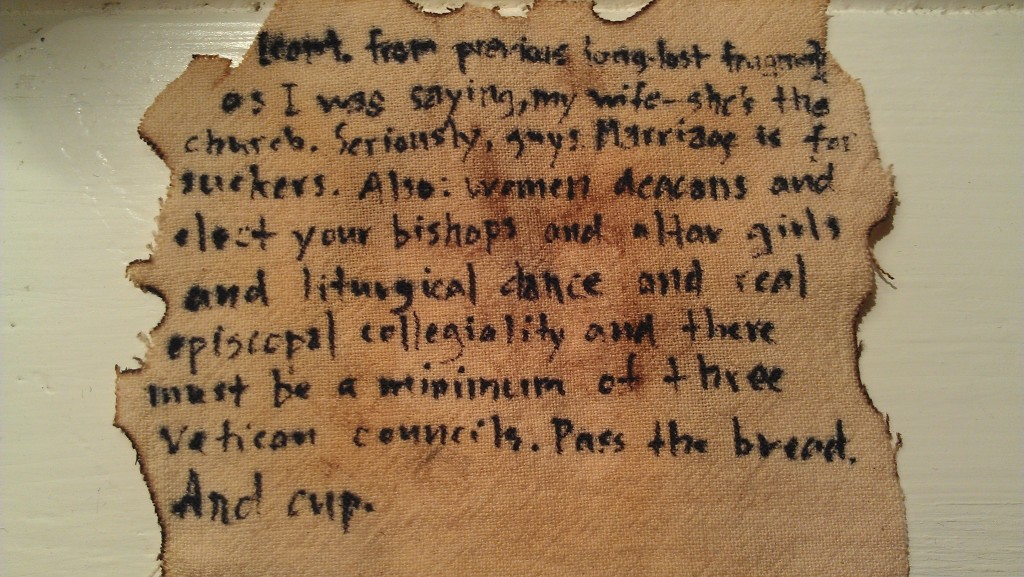Late last night, during a lavish banquet at an exclusive address in Chelsea, my Indiana Jones moment finally arrived. A mysterious man approached our dinner table and handed me a small box. "It's a gift. Just for you--" he said, and vanished.
"Who was that?" I asked my dinner companions. "He said his name was 'Grant,' but he smiled mischievously as he said that," reported one onlooker. Clearly "Grant" was a pseudonym, and a clever one at that. For what this middle man had given me was truly a gift.
By asking around at the fundraiser, I learned that this new papyrus -- hereafter P.Chelsea 1 (or P.Chels. 1 for citation) -- had been "granted" to me by an anonymous collector. Since I have recently been blogging so much (too much, I fear) about new papyri, this anonymous collector thought I would be the perfect person to evaluate the contents of P.Chelsea 1. My editio princeps is forthcoming in the premier journal, Collecteana: L'Revue d'Anne Papyrologique (CRAP), but my initial commentary follows below the photo:
Upon close inspection, this is not a papyrus at all! Rather, it's a parchment or vellum similar in texture and size to P.Dura. 24. It has survived the centuries well, and perhaps was folded and carried as an amulet. A peculiar feature is its smell: it has a stain in the center that resembles the odor of shoes -- or barbecue sauce. My preliminary conclusion -- pending further tests, of course -- is that this is an ancient parchment originally used to clean barbecue sauce off of someone's shoes.The scribal hand is competent but not elegant, clearly the work of a semi-professional, probably not someone whose primary work is the crafting of language.
Of orthographic interest is the first word of line 3. What is frustrating is that, just at the crucial point in the text, "...as I was saying, my wife -- she's the ......," the end of that sentence is difficult to discern. Did Jesus say "my wife is the church" or "my wife is the cherub?" The final "h" of church looks more like a "b" than an "h" for this unpracticed hand. (Cf. line 5 where "b" and "h" are properly formed without false oblique strokes.) And we know that chureb was a common variant (by metathesis or parablepsis) for cherub in texts of the time period.
The reading of this word greatly influences the meaning of the text. Was Jesus' wife metaphorically the church, as in the New Testament? Or was Jesus' wife really a cherub, an angelic being, as in some Gnostic texts from antiquity? Professors Crispin Fletcher-Louis, Bogdan Bucur, and other experts in angelomorphic Christologies from antiquity could not yet be reached for comment.
The provenance of the fragment is obviously of great concern to us. Its language (English) would seem to indicate an origin in an English-speaking country, and yet we know from our canonical texts that Jesus dined with disciples after his glorious Resurrection (Luke 24; John 21) AND that the disciples were spiritually empowered to speak foreign languages (Acts 2). Nothing about the papyrus then necessarily demands a modern date.
Its discovery in New York, however, may provide a clue. Its focus on the issue of Jesus' marriage, coupled with staunch congregationalism ("elect your bishops"), calls to mind an English-speaking Christian group with roots in upstate New York: the Mormons. It is possible, though unverified, that this fragment comes from a revelatory meal dialogue, post-Resurrection, post-Redescension, in North America. Such a theory coheres well with the indisputable smells of shoes and barbecue sauce.
Therefore, my preliminary conclusion is that we have here a fragment from a similar textual tradition and milieu as the recently discovered Coptic papyrus. The connection is encouraged by line 1, which says, "[cont. from previous long-lost fragment]." On the other hand, line 1 seems to be written by a different hand ("Hand 2" in forthcoming critical edition), which I have concluded is that of the anonymous modern collector. Having seen the news last week about the Coptic papyrus, he himself wrote this helpful instruction at the top in square brackets. My assessment then, is that this new fragment represents a branch of the same textual stemma as the Coptic papyrus, but this one carries us across the ocean, likely in the pocket of the cloak of Jesus himself, to the New World. After Jesus dined with his disciples in the New World, he washed their feet (John 13), thus cleaning off the barbecue sauce (a New World food) that had splattered during their meal.
Those skeptical of Mormon provenance point to the fragment's evident interest with issues of interest to modern American Catholics (e.g., "the cup" instead of the "chalice"). On the other hand, "women deacons" were well attested in antiquity and late antiquity, as were episcopal elections. Liturgical dance goes all the way back to David himself (2 Sam 6:14), and thus cannot help us date the fragment.
Other scholars have demanded that I have the ink tested prior to publication. That would not be normal operating procedure in papyrology, and it's quite expensive and time-consuming. I would like to satisfy the demands of these scholars, but my research budget is precisely zero dollars. Therefore, I will be taking up a dreaded "second collection" at church this weekend to try to cover those costs. Alternatively I might agree to do a television special in order to defray the costs of the ink tests sure to be demanded from all corners of the blogosphere. If you'd like to contribute to further study of P.Chels. 1, and other legitimate papyri, click here.
Please email comments to [email protected] and join the conversation on our Facebook page.
Previous Story
The Council that might have been
Next Story
Bishops fret about being too political

